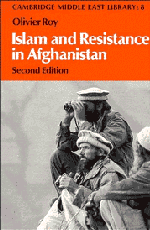Book contents
- Frontmatter
- Contents
- Acknowledgements
- Maps
- Introduction
- 1 State and society in Afghanistan
- 2 Islam in Afghanistan
- 3 The origins of Afghan fundamentalism and popular movements up to 1947
- 4 The Islamist movement up to 1978
- 5 The communist reforms and the repression, 1978–9
- 6 The uprisings, 1978–9
- 7 The establishments of political parties
- 8 The development of the parties between 1980 and 1984
- 9 The role of the Shiʿa in the resistance
- 10 Society and the war
- 11 From freedom fighter to guerilla
- 12 Military operations
- 13 The conflict from 1986 to the Soviet withdrawal
- 14 Cultural patterns and changes in society: an assessment
- 15 Afghan politics and the outside world
- Appendixes
- Notes
- Bibliography
- Index
9 - The role of the Shiʿa in the resistance
- Frontmatter
- Contents
- Acknowledgements
- Maps
- Introduction
- 1 State and society in Afghanistan
- 2 Islam in Afghanistan
- 3 The origins of Afghan fundamentalism and popular movements up to 1947
- 4 The Islamist movement up to 1978
- 5 The communist reforms and the repression, 1978–9
- 6 The uprisings, 1978–9
- 7 The establishments of political parties
- 8 The development of the parties between 1980 and 1984
- 9 The role of the Shiʿa in the resistance
- 10 Society and the war
- 11 From freedom fighter to guerilla
- 12 Military operations
- 13 The conflict from 1986 to the Soviet withdrawal
- 14 Cultural patterns and changes in society: an assessment
- 15 Afghan politics and the outside world
- Appendixes
- Notes
- Bibliography
- Index
Summary
The Hazara represent the core of the Shiʿa movement in Afghanistan. As they are concentrated in the central mountains, they play a very important strategic role for the resistance movement, for Hazarajat is both an important junction in the communications network and an area of refuge untroubled by the battles being waged elsewhere. Since 1981 the Russians have abandoned any pretence of controlling this region. Deprived of the opportunity of waging war against them, Hazarajat has been plunged into a simmering civil war, punctuated by sudden outbreaks of violence. The Shiʿa are very clearly distinguished from the Sunni majority by their bearing, their political allegiance and the structure of their organisations. Only one Shiʿa party is really active against the Russians: the Harakat-i islami, which originated in the town (thus qizilbash, but is now well established along the borders of Hazarajat.
Hazarajat
The situation before the war
The origin of the Hazara and their social organisation prior to the twentieth century is obscure. It seems that the tribal system, dominated by the mir, was the rule – a system that was much more hierarchical and rigid than Pashtun tribalism. Even today, the Hazara are marked by an absence of egalitarianism and by the harshness of their social relations, in which respect they are strikingly different from the other ethnic groups.
- Type
- Chapter
- Information
- Islam and Resistance in Afghanistan , pp. 139 - 148Publisher: Cambridge University PressPrint publication year: 1990



